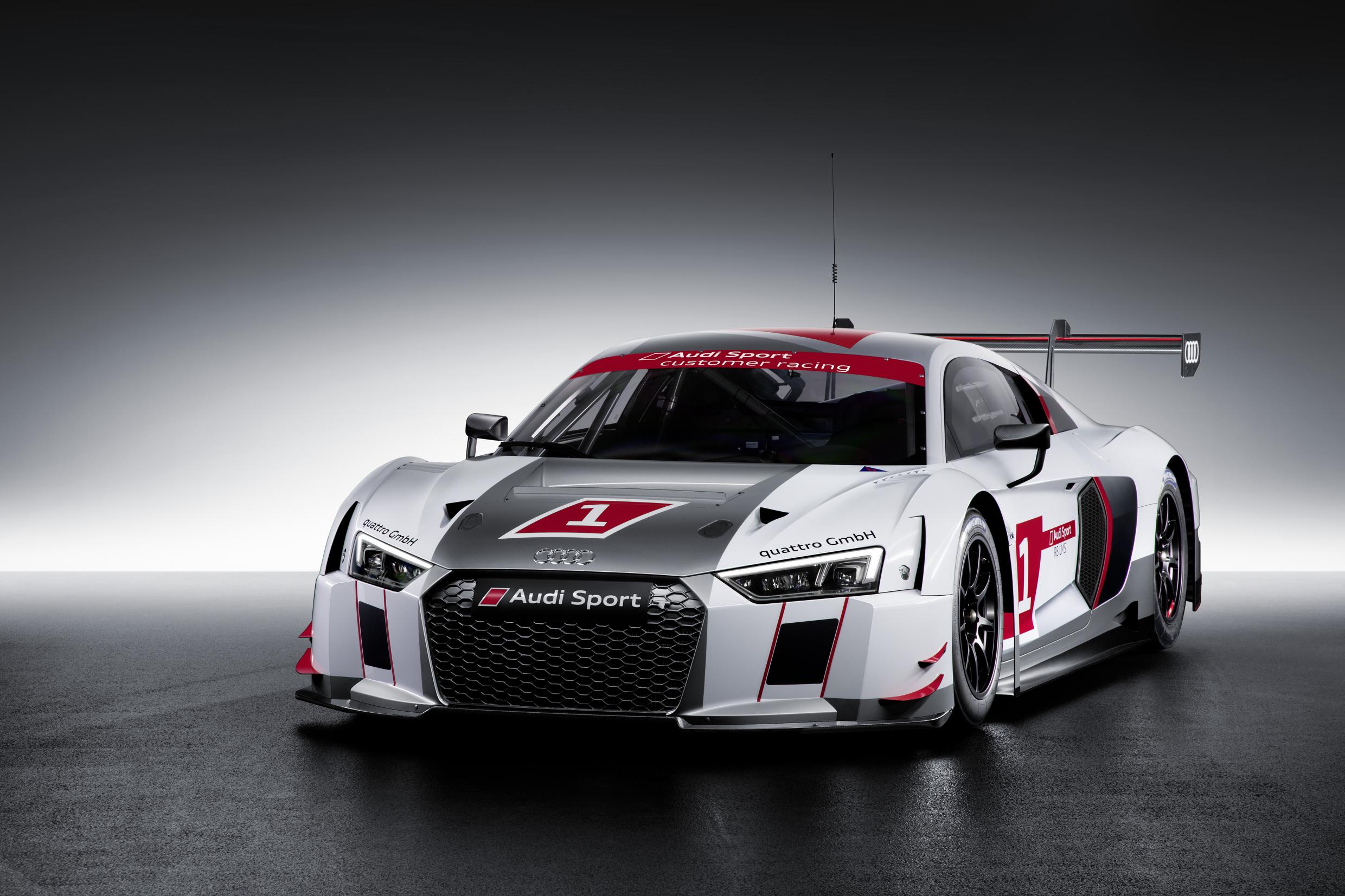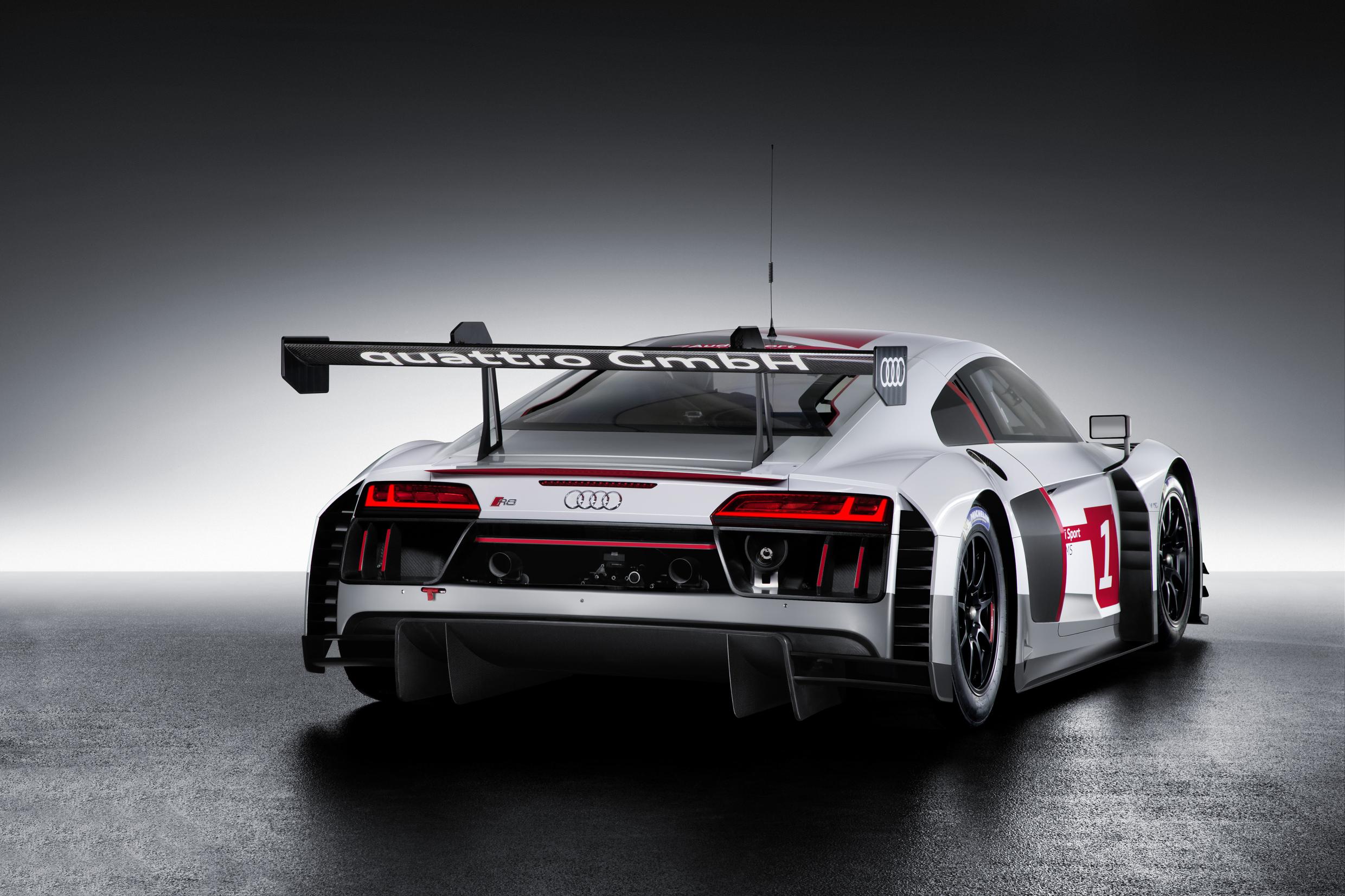
ESTABLISHES NEW RACE CAR GENERATION: LIGHTER AND SAFER THAN EVER BEFORE
Ingolstadt, March 3, 2015 – Audi is again running in front. As one of the first automobile manufacturers to do so at the beginning of the 2015 season, the brand with the four rings is presenting a race car that already meets the requirements of the new GT3 regulations to be introduced in 2016. The new Audi R8 LMS is lighter and safer than ever before. It features even more race car technology, clearly improved aerodynamics and, as a result, provides customers with an efficient concept.
Back in spring of 2014, Audi began testing the new R8 LMS that is following in big footsteps. The track record of the first generation of the Audi R8 LMS reflects 26 GT3 Championship wins between 2009 and 2014, plus 23 titles in other classifications and seven overall victories in 24-hour races. In 2015, customers around the world are again relying on the success model from Neckarsulm of which the company has sold more than 130 cars worldwide since 2009.
The first racing commitments of the new R8 LMS such as the 24-hour races at the Nürburgring (May 16/17) and at Spa (July 25/26) have already been scheduled. quattro GmbH that develops and assembles the race cars will begin to take customer orders in the second half of the year and is planning to deliver the first models of the second generation by the end of 2015.
At the same time, on presenting the successor model, Audi is preparing for the promising future of GT3 racing and plays a pioneering role in the process. The new Audi R8 LMS clearly surpasses the safety requirements of the regulations to be introduced in 2016. Thanks to a modified structure of the front end and a CFRP crash element at the rear that is being used for the first time the GT3 race car meets the crash test requirements that apply to the much lighter Le Mans prototypes (LMP) such as the Audi R18 e-tron quattro. The Audi Protection Seat PS 1 that will also be used in the R8 LMS in the future has been setting seating technology standards in the LMP class for years. It is connected to the chassis for increased stiffness. A quickly adjustable foot lever system and a height and length adjustable safety steering column allow versatile adjustment to the various drivers. A rescue opening in the roof as used in DTM race touring cars is now being introduced in a GT3 race car for the first time as well. After an accident, it allows the driver’s helmet to be lifted in a way that avoids straining the spinal column.
Audi systematically leverages its lightweight design expertise in the new R8 LMS. Despite the additional weight resulting from the above innovations the base weight of the race car has been reduced from 1,250 to 1,225 kilograms. The intelligent material mix of aluminium in the Audi Space Frame (ASF), a structural CFRP component and the steel roll cage alone make the chassis about 30 kilograms lighter – now weighing 252 kilograms. At the same time, the torsional stiffness of the stressed frame has increased by 39 percent.
Although the material mix in a race car is more complex, Audi has managed to integrate the manufacturing process for production and race cars even more closely than before. In a new manufacturing facility at the Böllinger Höfe industrial park in Heilbronn, quattro GmbH produces both variants in combination. Although the race car, for example, is fitted with aluminum cast joints and a steel roll cage the racing chassis of the R8 LMS remains integrated in the basic production process up to and including the stages of roof assembly and cathodic dip painting (CDP), which is a form of priming. Following these production steps, the race cars are completed in Heilbronn-Biberach.
Audi uses production parts in the new R8 LMS whenever this makes sense in racing from a technical and economic point of view. For example, the V10 engine with 5.2 litres of displacement and a power output of up to 430 kW (585 hp) leaves the same line as the production unit. It remains nearly unchanged and, with a scheduled rebuild interval of 20,000 kilometres, stets standards in racing. The engineers use modified or completely new assemblies whenever this is required in racing by the regulations or by the clearly higher loads that occur in competitive conditions. The production ASF chassis, for instance, is modified whereas the completely new bodywork is made of CFRP. The suspensions now use wishbones strictly designed for racing for the first time and the six-speed transmission with paddle shifters is a completely new development as well. It is significantly lighter than its predecessor while its efficiency has increased because the previous drop gear system has been eliminated. The new MS 6.4 electronics include engine electronics, traction control and software for the electro-hydraulic gearshift. The powerful processor enables higher processing speeds that result in faster responses. A power box is another new feature. It replaces the traditional fuse box and makes it possible to define individual loads and scenarios.
The new aerodynamic concept of the Audi R8 LMS for the first time includes a fully lined underfloor and a conceptually integrated rear diffusor. As a result, the dimensions of the rear wing can be reduced without a corresponding increase of aerodynamic drag. The wheel wells, which are open rearwards via a larger cross-section, contribute to improved airflow. The airflow rate and cooling area of the radiator at the front have increased by ten percent to handle maximum outside air temperatures. In order to improve the race drivers’ ability to concentrate on their tasks, fresh air circulation in the cockpit has been improved. At a speed of 200 km/h, the airflow rate is 250 litres per second. Audi has achieved these improvements despite the significantly higher constraints imposed on aerodynamics design by the 2016 regulations.

- First fielding of GT3 race car in VLN opener
- Phoenix Racing and Belgian Audi Club Team WRT are race teams
- Strong driver line-up for the 24-hour races at the Nürburgring and at Spa
Ingolstadt, March 23, 2015 – On March 28, the new Audi R8 LMS will be facing its baptism of fire in the VLN Endurance Championship Nürburgring. Seven weeks later, one of Germany’s major races will follow, with four new R8 LMS cars battling for success in the Nürburgring 24 Hours on May 16 and 17. On July 25 and 26, the world’s major GT3 race, the Spa 24 Hours, will be held. On board: four driver squads with Le Mans winners, an FIA WEC World Champion and Audi Champions from DTM and GT racing.
The Audi R8 LMS was in the spotlight at the Geneva Motor Show just recently, at the beginning of the month, and about three weeks later it has to prove itself for the first time in the ‘Green Hell’ of the Nürburgring. The Audi R8 LMS will be competing there on the last weekend in March. In the opening race of the VLN Endurance Championship, the Belgian Audi Club Team WRT and Team Phoenix Racing will each be fielding one of the brand new GT3 race cars. Both teams have excellent references. The Belgian team of Vincent Vosse decided the Spa 24 Hours in its favor last year, while Ernst Moser’s Phoenix squad based in the Eifel won the endurance race on its doorstep.
“Our new Audi R8 LMS is ready for a rigorous testing program in racing conditions,” says Romolo Liebchen, Head of Audi Sport customer racing. “We selected the two toughest 24-hour races in Europe that GT3 cars are permitted to compete in. In Phoenix Racing and the Belgian Audi Club Team WRT we’ve got two teams that have been spoiled by success at our side. Towards the end of the year we’re going to deliver a powerful new race car to our customers.”
Successful Audi race drivers from various motorsport series are going to take turns at the wheel of the Audi R8 LMS in the events at the Nürburgring and at Spa. The former DTM Champion Mike Rockenfeller and his fellow Audi driver Nico Müller, the Le Mans winners Marcel Fässler and Stéphane Ortelli, WEC driver René Rast, last year’s winners at the Nürburgring and at Spa, plus many other top-caliber GT drivers are completing the line-up of both teams.
In addition, the new Audi R8 LMS will be competing in selected other races in the 2015 season, such as the second VLN race on April 25 and individual rounds of the Blancpain Endurance Series.
The driver line-ups of Audi Sport customer racing
March 28, 2015, VLN 1
Belgian Audi Club Team WRT
Christer Jöns/Nico Müller/Edward Sandström/Nicki Thiim (D/CH/S/DK)
Phoenix Racing
Marc Basseng/Christopher Haase/Mike Rockenfeller/Frank Stippler (D/D/D/D)
May 16–17, 2015, Nürburgring 24 Hours
Belgian Audi Club Team WRT
Christopher Mies/Nico Müller/Edward Sandström/Laurens Vanthoor (D/CH/S/B)
Christer Jöns/Pierre Kaffer/Nicki Thiim/Laurens Vanthoor (D/D/DK/B)
Phoenix Racing
Christopher Haase/Christian Mamerow/René Rast/Markus Winkelhock (D/D/D/D)
Marc Basseng/Marcel Fässler/Mike Rockenfeller/Frank Stippler (D/CH/D/D)
July 25–26, 2015, Spa 24 Hours
Belgian Audi Club Team WRT
René Rast/Laurens Vanthoor/Markus Winkelhock (D/B/D)
Nico Müller/Stéphane Ortelli/Frank Stippler (CH/MC/D)
Phoenix Racing
Marcel Fässler/Christian Mamerow/Mike Rockenfeller (CH/D/D)
Christopher Haase/Christopher Mies/Nicki Thiim (D/D/DK)
